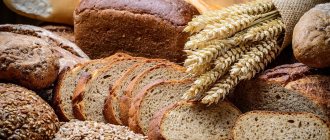Popular wisdom says: “No bread - teeth on the shelf.” Therefore, housewives try to have a supply of loaves and rolls at home, but not everyone knows how to store bread correctly. You cannot throw away the product, because this is disrespect for people’s work, a sign of the loss of family well-being and prosperity. Meanwhile, to prevent bread from becoming moldy or stale at home, it is enough to choose any of the eight proposed storage methods.
Why does bread spoil quickly?
Bread is included in the list of perishable products due to its composition. You've probably noticed that a loaf bought in the morning loses its freshness, taste and aroma by the evening. If the bread has been untouched for several days, mold may appear on its surface.
Modern bread is very different from the products that our grandparents ate. Then it simply became stale and dried out, and now even after 2-3 days of storage it becomes moldy. This phenomenon can occur due to various reasons:
- a large number of impurities and emulsifiers have been added to the composition;
- stale raw materials were used;
- production technology is disrupted;
- storage and transportation standards are not met;
- non-compliance with safety regulations at work.
To always buy fresh rolls and loaves, pay attention to several characteristics:
- Crust condition. It should be smooth without burnt areas.
- Crumb density. It shouldn't crumble.
- Aroma. Its absence or change indicates that the product has been sitting for a long time.
It is best to buy bread from a trusted seller, who will tell you how long the loaves, if they are unpackaged, have been lying on the counter.
Is the freezer the right place?
Do not freeze bread unless it is fresh, warm or stale. Such protection is permissible for a maximum of four months. At a temperature of minus 18, this product can be stored for up to six months. Repeated freezing is not advisable.
Cut the loaf into large pieces, packing in small portions in foil. You can remove the slices by reheating or letting them “thaw” at normal room temperature. Then the fermentation process starts again. Consume "frozen savings" within 2-3 hours maximum, while they are soft.
What material to use for storing bread
The product will stay fresh longer if you choose the right storage container. Natural fabric or paper copes well with this function. Plastic, polyethylene or foil also preserve the freshness of bread well. However, when using them, take care of ventilation inside, since condensation appears on the inner surface of such materials.
How to choose a bread box?
The kitchen utensils market offers a huge number of models. It will be easier to decide which bread box is better if you take into account the following points:
- The bread box should match the style of the kitchen;
- accommodate the required amount of bread;
- be convenient to use;
- match the size of the available space in the kitchen;
- have no manufacturing defects (chips, scratches can be a breeding ground for bacteria);
- have no foreign specific odors;
- the material must be suitable for contact with food (especially plastic models need to be checked);
- have an attractive design.
Vacuum bread bins
Any product is best stored in an airless space. You can find vacuum bread bins on the market. They are a container for bread with a valve to release air. A special pump pumps out the maximum amount of it to create the atmosphere necessary for storage. Vacuum models are easy to use and maintain, and are also ergonomic. They are unlikely to be convenient for daily use, but are suitable for those who buy bread with a spare. The only negative is that you can only store one type of bread.
Two-tier bread box
It is recommended to keep different breads separately. For such a case, the best bread bin is a model for separate storage. Mostly these options are made two-tiered so that they take up no more space than regular ones. The compartment sizes may be the same or different. For example, one loaf of bread will fit on top, and two or three below. The compartments can be shelves with a partition or separate units.
Wall-mounted bread bin
When there is not enough space in the kitchen, it is worth taking a closer look at wall-mounted options. A hanging bread bin can be located on the wall or on a rail. Attach to nails (screws) or hooks. The second option is more convenient because the structure can be removed and washed at any time, or simply shake out the crumbs. Wall-mounted bread bins are equipped with lightweight hinged lids that make them easier to use. Sometimes the lids on wall-mounted models have magnets. Some hanging bread bins are made in the form of separate boxes, with the stand and hooks separated.
Bread box with cutting board
For those who do not like to clutter up space or decorate their kitchen in a minimalist style, a harmonious model has been created - a bread box with a cutting board. The cutting board can act as a lid or door to the bread bin, be its bottom or built-in (pull-out). Such models save space and take care of consumer health. After all, the cutting board will be used only for bread, which prevents the ingress of bacteria or mold from other products. Some models with a cutting board also have a compartment for storing a knife.
At what temperature should you store bread?
The optimal temperature for storing bread is 20–25 degrees. In this temperature range, the product retains its best consumer characteristics. Like many other products, baked goods do not tolerate sudden temperature changes. Make sure that the room where the bread is located is well ventilated, dry and clean, and the relative air humidity does not exceed 75%.
Breadbox - a traditional way of storage
So, how to properly store bread? Much depends on which varieties you prefer:
- Someone buys loaves from the store - they are often already cut and packaged in plastic.
- Others buy baked goods at kiosks while they are still hot.
- Still others bought a bread machine and bake at home.
But there are general rules for storing bread at home that should be followed.
For bakery products it is necessary to create special conditions. Many housewives have purchased bread bins - made of plastic, metal, wood. If you don't know what to give to your friends, this item will be a good gift.
- A plastic bread box is light, inexpensive, and easy to clean. However, it is short-lived.
- The metal one will serve you for many years. It is also easy to care for.
- But the best option is wooden. Where can I buy one? Most often at the market, with craftsmen.
There is only one “but” here. After you wash the wooden bread box, dry it so that it does not become damp.
Note to the hostess
Instead of washing a wooden bread box, you can use filling (burning). Soak a cotton swab in ethyl (medicinal) alcohol and set fire to the cotton swab directly in the breadbox, covering the lid. Fire is the enemy of fungi and bacteria.
The loaves will be stored especially long in a bread box made of juniper
Why does bread mold in the bread bin?
Most likely, the raw materials for baking were of poor quality and already contained mold spores. Once in a favorable environment in your kitchen, where it is warm and humid, these spores grow wildly. Or mold remained in the bread bin after you threw out the previous spoiled loaf.
- If mold occurs regularly, ventilate the room where the bread bin is located more often and wash it every time before putting in a fresh loaf.
- If bread of the same type from a certain manufacturer becomes moldy, simply refuse to buy it.
How to store freshly baked bread
If you are pampering your family with fresh baked goods, prepared yourself, take into account the following rules:
- Try to remove the product from the mold as quickly as possible, otherwise the crust will not be crispy.
- Do not pack hot bread until it has cooled completely.
- For storage containers, use a plastic or paper bag, a towel made of natural fabric, or simply put the baked goods in a bread bin.
DIY bread box
You can make a model suitable for your interior yourself. A do-it-yourself bread box made of wood will be available. There are models that combine wood and bamboo napkin. It is easier to make a bread box, which is made without the use of glue and accessories. First you need to prepare the tools, determine the required dimensions and select the material. For production you will need:
- plywood 8 mm thick (you should choose deciduous wood, coniferous trees cannot be used);
- jigsaw;
- electric planer or milling machine;
- ruler;
- pencil;
- clamps;
- glue.
This bread box is made without accessories. Its door acts as a cutting board. The work plan is as follows:
- Transfer the drawing to plywood and cut out the blanks with a jigsaw.
- In the side parts, when they are not yet divided, cut grooves with an electric plane (in accordance with the dimensions of the plywood).
- The groove is partially made in the rear wall.
- After cutting out all the parts, glue them together.
- After drying, decorate the bread box to your taste (paint, use decoupage technique).
Where is the best place to store bread at home?
Most importantly, do not leave the finished loaf outdoors, especially in direct sunlight. To keep the product fresh for as long as possible, use various storage devices.
Foil or plastic bag
Polyethylene or foil do a good job of preserving the freshness of bread, but only with proper storage. Basic rules for storing bread in a bag or foil:
- Use only a new bag or piece of foil to avoid mold.
- Close the package tightly to prevent the bun from drying out.
- At the same time, do not allow moisture to collect inside. To do this, make several small holes in the packaging.
In the original polyethylene packaging, the bread will last for at least 3 days, provided that you close the bag tightly.
Paper, textile or clay
This storage method came to us from our grandmothers. In the old days, it was customary to wrap bread in a piece of natural fabric. This way it could stay fresh for at least 2 days. The method is still popular among many housewives. Use kitchen towels made from natural materials without a pattern or a special fabric bag for bakery products for storage. The bags consist of 3 layers: the outer and inner are breathable materials, the middle is perforated polyethylene. You can buy similar devices in the hardware department of the supermarket.
An excellent place for storage would be paper bags, which are often sold in stores. The material prevents the product from drying out, breathes well, and does not allow moisture to pass through. In a closed paper bag, the loaf will remain fresh for up to 3 days.
An alternative to a bread box is a simple clay pot. The material will help keep the product fresh for 5–7 days. To achieve these results, simply cover a fresh loaf with a clay pot.
Vacuum
In vacuum packaging, bread can last from 7 to 10 days. After this time, the product will remain as soft and fresh as it was before storage.
Breadbox
A classic option for storing bread. In addition to its main function, the bread box also acts as an element of kitchen decor. In the range of products for storing food you will find products made of metal, wood, plastic or clay. Each material has different performance characteristics.
The loaf can stay fresh for up to one week if you first wrap it in a linen towel and make sure the lid of the bread bin is always closed
In paper
In supermarkets, baked goods are often sold in special paper bags in the bakery departments. They are suitable for storing loaves, protect from dust, dirt, allow the bread to “breathe”, but do not protect against drying out. For 1-2 days of storage, this method will do; for a longer period, other options should be considered.
Can bread be stored in the refrigerator?
Some housewives keep bread in the refrigerator and claim that it stays fresh for 5-7 days. On the one hand, the refrigerator helps to avoid the appearance of mold, since the temperature from 0 to 2 degrees prevents its occurrence. On the other hand, such a temperature lowers the level of moisture in products, so the bread goes stale much faster.
If you decide to keep the loaf in the refrigerator, don't neglect packaging it. Wrap the loaf in paper or cloth. When using plastic bags or foil, make sure there are holes in the surface for ventilation.
Is it harmful to store bread in the refrigerator?
Of course, it’s up to you to keep the bread in the refrigerator or just in the room. However, please note that this storage option may cause problems:
- the bread will absorb the smells of other products lying on the shelf of the refrigerator next door;
- other foods will absorb the smell of yeast;
- if you place a loaf in polyethylene without holes, it will definitely become moldy;
- When a hot product is placed in the refrigerator, the compressor may become unusable due to the steam released by the bread.
How long can bread be stored in the freezer?
An interesting fact is that the rate of starch crystallization is significantly reduced at temperatures from -10 degrees. Based on this information, we can assume that the bread can last in the freezer for a long time. And indeed it is.
To keep the product for a long time at a temperature of -13 to -18 degrees:
- Place only fresh bread at room temperature into the chamber;
- be sure to pack the product in a bag or foil;
- do not refreeze the rolls;
- For convenience, mark the freezing date directly on the packaging or package the product in portions.
If these conditions are met, the bread will last in the freezer for 2 to 16 weeks.
Keep the frozen product at room temperature for several hours or use an oven, microwave or bread maker to defrost.
What kind of bread is not stored in the refrigerator?
If you are satisfied with the option of storing bread in the refrigerator, please note that it is unacceptable to keep certain types of products on the refrigerator shelf. Namely:
- hot baked goods, which will only harm the refrigerator compressor;
- already spoiled bread with mold appearing on the crust;
- bakery products without packaging.
Otherwise, for this storage option, you can choose any type and variety of products.
Secrets of long-term storage
– Bread will be tasty and healthy for a long time if you follow these tips:
– Place peeled potatoes or apple slices in a container. These products absorb excess moisture and prevent the loaves from hardening.
– A hot, freshly baked loaf should be cooled. Leave for 3 hours, pack.
– Store the rolls in closed containers and pans in additional packaging.
– The old method recommends: first divide the loaf into two parts. Cut the required number of pieces from the center. Remove the rest by pressing with the cuts.
– Keep the product in bags containing 3 layers: fabric inside and outside, plastic between them. the product will remain soft for 3-4 days.
– Cut and sew the bags. Soak in saline solution. Dry without rinsing with water.
To choose the right storage method, try them all and settle on the one that suits you.
Which bread box is best to store bread in?
You can understand which bread box is better by analyzing the characteristics of products made from various materials.
Bread bins:
- made of wood have the highest hypoallergenic and antiseptic properties, but require the most careful care and can become damp;
- made of plastic - cheap and practical, but quickly deteriorate;
- made of clay or glass perform well, but are too fragile;
- made from metal has the best heat and aroma retention properties, are durable and easy to care for, but are slightly more expensive than analogs made from other materials.
When choosing a product, think about what characteristics come first for you, and make a choice based on your preferences. When purchasing, make sure that the lid closes tightly and that there are as few ventilation holes on the body as possible.
If you usually buy several types of bread at once, give preference to bread bins with several sections. Otherwise, keep products with different compositions by packing each in a separate bag.
Bread bin or refrigerator?
For safety, it is customary to use a bread bin. In the refrigerator, bread tends to become stale and dry out. Also there it easily absorbs foreign odors. This leads to loss of aroma and taste.
There are bread bins made of metal, glass, plastic, and ceramics. But the best choice would be wood. It decorates the kitchen and even has antiseptic properties. The metal bread box does not absorb odors, maintains temperature, and lasts a long time. Such a thing requires less care than a wooden product, which can become damp. A modern metal bread box has a ventilation hole.
You can use a refrigerator. This long-term method for safety is resorted to when it’s hot outside, or you need to greet guests, but you’ve bought groceries, or you’re just too lazy to go to the store. But don’t “save” it if white spots have already appeared. After all, fungal spores can easily spread further.
How to store so that bread does not go moldy
To prevent mold from appearing on the crust for as long as possible:
- Place a handful of salt or an apple slice in the place where you store your baked goods. As soon as the apple begins to rot, replace the old slice with a new one;
- Keep the bread bin clean - wash the inside surface weekly with water and vinegar and do not allow moisture to remain inside;
- remove crumbs from the bread bin in a timely manner;
- a product prepared with vegetable rather than animal fats is less susceptible to fungus;
- Always keep the bread bin closed.
To prevent baked goods from becoming stale, cut the loaf not from the edge, but from the middle. After cutting the required number of slices, fold the halves crumbwise towards each other and pack.
Composition and technology
To prepare it, water, flour, salt, yeast or sourdough are used. Rye or wheat flour is used. In rare cases, products are baked from corn and barley. Very often, flour products are decorated with grains, nuts, raisins, sunflower seeds, sesame and poppy seeds.
Bread is given various shapes - oval, round, rectangular. To give lightness and airiness, gaseous substances are added to the dough. One such substance is buttermilk and soda. When combined, a sufficient amount of gas is released to give the product an airy appearance. When yeast is added to flour, a biochemical process occurs. Fermentation of carbohydrates and sugar releases carbon dioxide.
Some varieties are baked using sourdough. Lactic acid bacteria, which form the basis of the starter, feed on the products of yeast fermentation. As a result, they release lactic acid, which gives the bread a pleasant sourness.
Black and white together or separately?
This question applies not only to black or white bread, but to all its varieties in general. Due to differences in composition, products are influenced by the external environment at different times and under the influence of different factors. For example, one type of bread will spoil in a day, while another may last for 2-3 days. If the loaves are nearby, the bacteria from the spoiled product will transfer to the high-quality product, and it will also become unusable. To prevent this from happening, keep each variety separately, in different bags or in several sections of the bread bin.
Storage in special bags
Reusable special bags equipped with perforated gaskets are becoming popular. Thanks to the special structure of the material, packaged loaves, long loaves and rolls remain fresh for up to 10-12 days.
Due to perforation, excess moisture is absorbed, the crumb does not dry out, the bread crust does not soften, and mold does not form. The bags are sold in sets, and manufacturers produce packaging in different sizes - “long” for baguettes and standard for regular loaves and loaves.
How to store different types of bread
The components that make up different types of bread have different properties. This means that one type of baked goods can stay fresh for a long time, while another cannot.
Wholegrain
In the production of whole grain bread, sprouted wheat seeds are used, thanks to which the product is considered very healthy. When choosing such baked goods, pay attention to the ingredients on the packaging. The first component should be whole grain flour.
Also, the composition should contain a minimum of impurities and preservatives.
Real whole grain bread will stay fresh for 48 hours and 72 hours when packaged. Optimal storage conditions are a dry, ventilated room with a temperature of 20–25 degrees and a relative humidity of 75%.
Yeast-free
Despite the fact that bread is prepared without the use of yeast, it, like other varieties, can become stale. Typically, yeast-free bread can be stored for 7–10 days.
These terms are arbitrary and depend on the type and technology of baking. Storage conditions also affect the safety of the product. It is best to keep the loaf in plastic, paper, foil or cloth and put it in a bread bin or cupboard.
Gluten-free
Gluten-free varieties differ from classic ones in that they contain types of flour that do not contain gluten. Such products are usually consumed by people who are intolerant to the substance or who want to eat more healthily.
The best place to store gluten-free bread is in the freezer. Once prepared or purchased, cut the loaf into pieces, portion and freeze. Before use, heat the required number of servings in the microwave.
Otrubnoy
Products with bran differ from classic ones in that they contain bran in addition to flour. If you provide the bread with the proper conditions, keep it in cellophane, paper or a bread box, it will last 5-7 days without spoiling.
Bread crackers
Such a product can remain in its proper form from several months to two years, but only if the required level of humidity is maintained in the room (no more than 75%).
Storage nuances:
- It is better to keep crackers in a dark and cool place;
- At the first sign of spoilage, immediately discard the product;
- do not place crackers near the bread, otherwise both products will become unusable faster;
- be sure to keep the crackers in the packaging: plastic or paper bag, fabric bag, foil;
- Rusks that are dried rather than fried (especially with the addition of oil) last longer;
- if the composition contains additional ingredients, the shelf life is reduced;
- Use snack crackers immediately after opening the package.
In fabric
It is believed that this method is environmentally friendly and simple. The loaf is wrapped in a large linen napkin or towel and placed in a bread bin or any other container.
Instead of towels, fabric bags are suitable. The fabric must be natural, without mixed additives or synthetics. In this material, baked goods will remain fresh for up to 4-5 days.
Shelf life and storage of bakery products according to GOST
First of all, it is worth noting that the state standard for storing bread is established within the framework that is calculated for the sale of the product. This means that the actual shelf life of bakery products is slightly higher than the prescribed values. There are 2 types of GOST standards, which depend on the type of product, the method of its preparation and the presence of packaging.
- For products that can be stored for no more than 2 days. The packaging must contain not only the date, but also the time of packaging.
- For products that can be stored for more than 48 hours. The label will be marked with the date of packaging.
Storage standards for main types of bakery products:
- cut: in packaging – 72 hours, without packaging – 24 hours;
- white of the first category: in packaging 72 hours, without packaging – 24 hours;
- small loaves up to 200 g – no more than 16 hours;
- Borodinsky - 36 hours;
- crackers – 60 days.
Difference between old and stale bread
In fact, many people don't know the difference between old and stale bread.
In past centuries, it was believed that properly prepared old bread had its own character. As loaves age, amazing changes occur. Surely everyone has noticed that after a couple of days the bread crust is no longer crunchy, but the taste becomes more harmonious and fuller. That is, old bread is sometimes even better in taste than a fresh loaf, which cannot be said about a stale product. The process when bread goes stale is called starch retrogradation in the scientific world. This term refers to the transition of starch polysaccharides from a soluble state to an insoluble form. In other words, changes that occur with starch during storage of bread.
Starch tends to constantly change. In a loaf of raw dough, the starch has a crystalline structure. But when the loaf is placed in the oven, the starch undergoes a process of gelatinization.
It is the starch, swollen under the influence of moisture and high temperature, that provides the bread with softness. However, during storage of the loaf, the starch compounds become more elastic, rigid and lose their elasticity. This leads to callousness.
Both the aging of bread and its staleness are inevitable processes. But even they can be delayed a little, preserving the taste and properties of the bread crust. It is enough to store baked goods correctly.
How to preserve bread while traveling
If you are going on a hike or a picnic, take care of food. Typically, a tourist's food package also includes baked goods. To keep them fresh as long as possible:
- When choosing, give preference to varieties that have a maximum shelf life.
- Keep the products only in the packaging and do not allow moisture to get into it.
- Cut the loaf not from the edge, but from the middle. After cutting off the required amount, fold the halves and pack them in a bag. This way the bun will last longer.
A good idea would be to vacuum-pack the bread. Portion the product and pack it. Open one serving package before eating.
Bread will last longer if the necessary storage conditions are observed. The main thing is not to let the product come into contact with air or sun rays. Of course, it is better to buy baked goods for future use, but if this is not possible, use simple tips and tricks to help extend the shelf life.
Useful Tricks
It often happens that a whole loaf gets wrapped up or dries out. To avoid throwing away the product, you can try the following:
- sprinkle the loaf with purified water and place it in an oven preheated to 150 °C;
- put the bread in a colander and place it over boiling water, covering with a lid;
- heat the loaf in the microwave at maximum power (3-5 minutes) with a small container filled with water;
- prepare the casserole: cut the stale bread into small pieces. Pour in the egg-milk mixture and place in the oven.
Bread can rightfully be called the most popular product in stores. In order to fully enjoy its taste and not waste money, you need to know what kind of bread and how to store it correctly.
Is it possible to keep different varieties together?
Each person prefers his own type of bread. This is not a whim, but a requirement of the body. Technologists do not recommend mixing together white and black bread, rye and wheat, freshly baked homemade bread with stale bread in storage containers. It is better to place them in individual containers, bags, boxes.
Why you can’t store different types in one place:
- The composition of the microbiological environment depends on the starter or yeast used in baking. Joint storage can cause musty, unpleasant acidic odor in wheat buns;
- The percentage of moisture in some varieties is higher, in others it is lower. In one bread box, the moisture will be evenly distributed throughout the entire volume. For example, dry bread next to a bun will become moist and soft;
- white bread is more susceptible to foreign odors. Its aroma will be lost against the background of rye.











